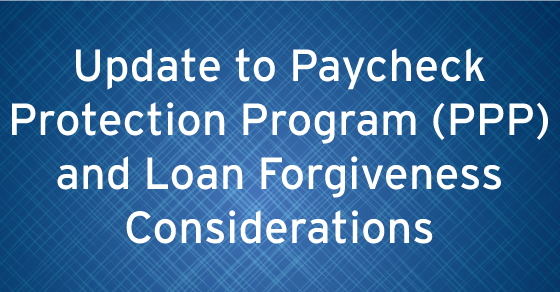4/24/20
By now, businesses that were fortunate to have their applications approved for PPP loans are starting to see the loan proceeds disbursed. However, many other businesses were left out as the predicted demand for PPP loans far surpassed the available PPP funds. Congress recently addressed this with PPP 2.0. The President has signed legislation that adds another 320 billion dollars for the PPP loan program. The legislation also adds an additional 60 billion in funding for other loans and grants for the Small Business Administration’s (SBA) disaster relief fund.
While we do not know exactly how the lending institutions will pick up in processing PPP applications or whether new applications will be required, this is certainly welcome news to those businesses in need of funds to continue business operations. As history is surely a guide in this case, if you are interested in securing a PPP loan for your business, time is of the essence. If you have a current PPP application in with your bank, follow up with them to make sure that you are ready to go when the funding is ready. If you were unhappy with the response of your current bank, consider applying elsewhere. Anecdotally, it seems the smaller banks were better in processing the applications for the first go around.
As we have been monitoring the various relief programs put forward in response to the COVID-19 pandemic, change and differing interpretations of the legislation have become the rule. This is not surprising given the urgency, magnitude and complications in drafting legislation that moves this much money through the system. We have seen guidance issued by Treasury and SBA that contradicts or is flat out not included in the original text of the CARES Act law. To say navigating the current legislative environment has been a challenge would be understatement.
With much of the PPP loan application process and related questions behind us, we now look toward the next phase of the PPP. The attractiveness of the PPP lies mainly in the ability for the loan to be forgiven. In some cases, it may be difficult to have the entire loan forgiven. Businesses should understand that it is possible that not all the loan will be forgiven.
There are still many questions or exactly how to apply some of the law to the forgiveness portion of the loan and there will likely be additional guidance issued by Treasury and SBA in the weeks to come. No hurry though—SBA changed the PPP application itself at least twice the week before the application start date with the final version coming at about 7pm on April 2, the night before banks started to accept applications.
WHAT WE’VE LEARNED (OR THINK WE KNOW), OPEN QUESTIONS AND ITEMS TO CONSIDER WITH PPP
1. No more than 25% of the forgivable amount of a PPP loan can be for qualified costs (rent, utilities, certain interest) other than payroll costs.
– This limitation is not specified in the Law itself, but rather a limitation imposed by the SBA with its Final Interim Rule (Section 2 (o)).
– Consequences can materially impact the amount of loan that can be forgiven meaning you may end up with more loan not forgiven than expected.
– Example: PPP loan of $100,000. Business has $50,000 in payroll costs and $30,000 in rent and utilities for the eight-week period. Due to the 25% other cost loan forgiveness limitation, the forgiven loan amount in this case would be $66,667. 75% of this amount is $50,000 and 25% of this amount is $16,667. This is a different result than businesses may be expecting.
– While we understand SBA’s rationale for this limitation, it has the effect of penalizing businesses that would rather not pay their employees for no work but still have ongoing fixed costs. We do not anticipate this aspect of the program changing, but an increase in the percentage of allowable other costs would be helpful to more businesses.
2. Best practices to account for the PPP loan
– Best practices suggest that a separate bank account be set up for the PPP loan proceeds so you can track qualified expenses and make the accounting for the costs easier at the end of the eight-week period. Make it easier for the bankers on the back end for loan forgiveness purposes.
– Only spend for qualified payroll costs and limit the expenses for the other items (rent, utilities or certain interest). There is a possibility that some portion of these expenses aren’t forgiven even if less than 25%.
3. If you aren’t using the PPP money to pay payroll for employees to work if they are able or to pay those not working if they can’t, the benefits of PPP proceeds might not be what you think they will be.
– The SBA Interim Final Rule (Section 2 (r)) indicates that “at least 75% of the PPP loan proceeds shall be used for payroll costs.” However, it does not say what will happen if less than 75% of the PPP loan is used for payroll purposes. Will the loan be called? The Interim Final Rule does say that this limitation is in place to be consistent with Congressional intent of keeping people employed and being paid. What if only a very small percentage is used for payroll? Will the borrower be able to keep the funds left over in this case with the two-year, 1% interest loan term? There are no answers to these questions.
– Some businesses may decide that having its employees collect unemployment is a better option. The enhanced unemployment benefits available as part of the CARES Act are very generous and employees could end up making more with unemployment benefits.
– Generous unemployment benefits could also be a hindrance to a business trying to hire back its employees, if they are getting a better deal collecting unemployment.
– Keep in mind that the employer portion of payroll taxes (FICA/FUTA) is NOT a “payroll cost” when it comes to the loan forgiveness calculation. So, you may end up in a situation where you are paying employees not to work (say because of a mandatory shut down) but the business will still be out of pocket paying the employer share of the payroll taxes.
– What happens to the amount of a PPP loan that remains unused at the end of the eight-week period? Is it automatically returned to the bank? Is it rolled into the two-year loan? Does the borrower have the choice if the money is still there at the end? The intent was clearly to assist businesses during the period from 2/15/20 through 6/30/20 reflected in the “covered period” for the PPP loans. Does it make sense that a business would be able to “save” this money, not use it during the covered period and use it later at a low 1% interest rate for purposes not intended under the PPP? If the intent is to use the funds later for items other than specified payroll costs/rent/interest/utilities is this violating the spirit of the PPP? We are going to need more guidance in this area as well.
4. Lenders are the gatekeepers to loan forgiveness
– The banks will be responsible for determining the amount of the PPP loan that will be forgiven. They will likely provide you with worksheets and schedules to help gather the information so they can make their determination.
– The loan forgiveness application that will be filed with the bank at the end of the eight-week period will include certifications that the information provided to the bank is true and accurate and will be the basis for the loan forgiveness decision.
– Any responsibility in connection with the loan lies between the borrower and the SBA. The banks are largely held harmless in this process if they dot their I’s and cross their T’s per SBA requirements.
5. What does it mean when they say that PPP loan amounts forgiven won’t be included in taxable income?
– Sounds simple enough, but the truth is we don’t know for sure.
– The CARES Act specifically states that amounts forgiven under the Act shall be considered canceled indebtedness under Section 7(a) of the Small Business Act. Which means that the canceled amounts aren’t included in taxable income.
– That sounds great that the amount forgiven won’t be considered taxable income, BUT will the amounts paid with federal government dollars be considered deductible EXPENSES to the business? Generally, expenses associated with tax exempt income are not also deductible, since this would lead to a double tax benefit.
– It remains to be seen how Congress or the IRS will clarify the treatment, but this is something that they will have to address.
6. Cash vs Accrual Basis for “costs incurred, and payments made” during the eight-week period for purposes of loan forgiveness
– To a CPA this wording is inconsistent and could mean virtually anything you want it to mean. Which in the case of The CARES Act where “license” by both Treasury and SBA was taken with interpretations and guidelines that aren’t supported in the Law itself, makes it very difficult to determine what the true intent is here.
– To a CPA the term “costs incurred” is an accrual concept. Regardless of when the expense item was paid, when was it incurred determines the period in which it is accounted. So, a utility bill received and paid in June that covered the month of May, was INCURRED in May and thus should be an expense for May.
– To a CPA, “payments made” is a cash basis concept. On the cash basis, an expense is considered and expense regardless of when it is actually incurred. So, using the cash basis in the previous example, the utility expense should be considered a June rather than a May expense.
– We do not know exactly how this will be further defined or how the banks will interpret this in the absence of further guidance from Treasury/SBA. We hope that SBA issues more guidance in this area or we will have the same inconsistency from bank to bank for this as we did for the PPP loan amount calculations.
– Our thought is that the payroll for the period will be the payroll incurred daily for the eight-week period and other items like rent and utilities will just end up being two months’ worth of bills. It doesn’t seem that the intent was to penalize businesses based on when they received the loan proceeds or how exactly the utility billing cycle due date corresponded to receiving and paying the funds. It also doesn’t seem like the intent was to make the bank’s job harder. They’ve already made it easy on the banks.
7. Beware of reductions in full-time equivalents (FTE) in calculating loan forgiveness
– Even after you slug through the calculations of payroll costs and the other costs and properly apply the 25% forgiveness limitation to the other costs, you still aren’t done. There is still yet another hurdle to get over before you can finally know the actual amount of your business’ loan forgiveness.
– We throw around the acronym PPP so often, that we need to be reminded of what those P’s stand for. It is the PAYCHECK PROTECTION PROGRAM. The intent is obvious- to give assistance to businesses to keep their employees working and getting a paycheck. Whether the PPP does a good job in accomplishing that goal is for another day.
– In keeping with that intent, part of the test in determining loan forgiveness percentage involves the average number of FTEs during the eight week covered period divided by average number of FTEs for one of two other designated periods of time (1) 2/15/2019- 6/30/2019 or (2) 1/1/2020- 2/29/2020 that were “unaffected” by the COVID-19 pandemic. The business can select either of the two periods which give the most favorable result.
– So, from our previous example: PPP loan of $100,000. Business has $50,000 in payroll costs and $30,000 in rent and utilities for the eight-week period. Due to the 25% other cost (non-payroll) loan forgiveness limitation, the PRELIMINARY forgiven loan amount in this case would be $66,667. This is the starting point.
– Now, we must look at the FTEs and their effect on the amount of forgiveness. Mind you that FTEs for this purpose is not specifically defined. We have seen a few different calculations but one used is the 30 hour per week definition. Two employees working 15 hours equals 1 FTE. So, let’s go with that for now.
– Assume that the average number of FTEs for period 1 (2/15/19-6/30/19) is 8 and the average FTEs for period 2 (1/1/2020-2/29/2020) is 10. Since this will be the denominator of the fraction that will yield the forgivable amount of the loan, smaller is better so we will use period 1 and its 8 FTEs. 8 will be the denominator in our fraction that will determine how much of the loan is forgiven.
– Further assume that the average number of FTEs for the eight-week covered period is 7. This will be the numerator in our fraction.
– The PRELIMINARY forgiven loan amount as per above is $66,667. For the FTE reduction multiply this amount by our fraction of covered period FTEs of 7/8 (7 is the number of FTEs for the eight-week covered period and 8 is the number of FTEs for the selected other time period) and the actual forgiven amount of the loan is $58,334. There are still additional ways that this fraction can further be adjusted based on rehiring employees by 6/30/20 but those details are still unclear.
– So now you think you are done and have an answer on how much of this PPP loan is forgiven. Well maybe, maybe not…
8. Beware of reductions in salary in calculating loan forgiveness
– There is yet another hurdle to clear to finally calculate the final amount of loan forgiveness on a PPP loan. This is based on reduction of salary in excess of 25% for the eight-week covered period when compared with an earlier pay period. As you will see, this calculation needs correction.
– The purpose for this part of the forgiveness test is to ensure that the employer does not cut salaries excessively during the covered period as compared to a “normal” period, without suffering a reduction in forgivable loan amounts.
– This reduction is a dollar amount specific to the earnings of each individual employee. For each employee determine total wages for the first quarter of 2020. Any employee who earned an annualized salary in excess of $100,000 in any single pay period can be excluded.
– For each employee not excluded (due to the 100K annualized limit) determine total wages for the eight-week covered period. Determine if any employee’s wages were reduced more than 25% when compared to the wages earned by that employee for Q1 2020. Add the dollar amounts in excess of a 25% reduction and reduce the loan forgiveness by this amount.
– The problem here is that the calculation requires that the individual employee’s wages for the eight-week period be compared to that employee’s wages for the FIRST QUARTER OF 2020. When you are comparing wages for the eight-week covered period with a full quarter of 2020 payroll (Q1), there is obviously an error in the drafting of the law that needs to be corrected.
– To take our example even further: PPP loan of $100,000. Business has $50,000 in payroll costs and $30,000 in rent and utilities for the eight-week period. Due to the 25% other cost (non-payroll) loan forgiveness limitation, the PRELIMINARY forgiven loan amount in this case would be $66,667. Then we had the reduction in forgiveness amount due to the FTE reduction of $8,333 for NEW PRELIMINARY forgiven loan amount of $58,334.
– Assume one employee and they made $10,000 over the eight-week period but made $22,000 over a similar eight-week period for Q1 2020 (assuming this is what Congress meant the law to say). The employee suffered a 54.55% reduction in wages or $12,000. A 25% reduction in wages would have only been $5,500. The reduction in the employee’s wages in excess of $5,500 or $6,500 ($12,000 less $5,500) would then FURTHER reduce the loan forgiveness amount.
– So, after you get over all the hurdles, the net loan forgiveness after all adjustments on the original PPP loan face amount in our example of $100,000 would be $51,854 ($58,334 less $6,500).
As you can see, there are many things to think about to spend your PPP loan proceeds efficiently. And for those that have not applied for PPP and are eligible we suggest that you gather your information and reach out to your bank and apply as quickly as possible. If you have a pending application, call your bank and make sure it is ready to go when PPP is back up and funded. This second round of funding isn’t going to last long, and we do not know if Congress will do PPP 3.0.
If you have any questions about PPP or any of the various loan programs or other aspects of the CARES Act, please reach out to your Maillie representative via phone or email.





